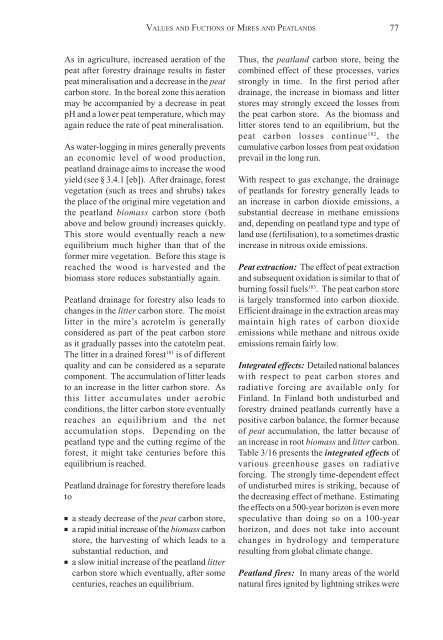wise use of mires and peatlands - Peatland Ecology Research Group
wise use of mires and peatlands - Peatland Ecology Research Group
wise use of mires and peatlands - Peatland Ecology Research Group
Create successful ePaper yourself
Turn your PDF publications into a flip-book with our unique Google optimized e-Paper software.
VALUES AND FUCTIONS OF MIRES AND PEATLANDS77As in agriculture, increased aeration <strong>of</strong> thepeat after forestry drainage results in fasterpeat mineralisation <strong>and</strong> a decrease in the peatcarbon store. In the boreal zone this aerationmay be accompanied by a decrease in peatpH <strong>and</strong> a lower peat temperature, which mayagain reduce the rate <strong>of</strong> peat mineralisation.As water-logging in <strong>mires</strong> generally preventsan economic level <strong>of</strong> wood production,peatl<strong>and</strong> drainage aims to increase the woodyield (see § 3.4.1 [eb]). After drainage, forestvegetation (such as trees <strong>and</strong> shrubs) takesthe place <strong>of</strong> the original mire vegetation <strong>and</strong>the peatl<strong>and</strong> biomass carbon store (bothabove <strong>and</strong> below ground) increases quickly.This store would eventually reach a newequilibrium much higher than that <strong>of</strong> theformer mire vegetation. Before this stage isreached the wood is harvested <strong>and</strong> thebiomass store reduces substantially again.Peatl<strong>and</strong> drainage for forestry also leads tochanges in the litter carbon store. The moistlitter in the mire’s acrotelm is generallyconsidered as part <strong>of</strong> the peat carbon storeas it gradually passes into the catotelm peat.The litter in a drained forest 181 is <strong>of</strong> differentquality <strong>and</strong> can be considered as a separatecomponent. The accumulation <strong>of</strong> litter leadsto an increase in the litter carbon store. Asthis litter accumulates under aerobicconditions, the litter carbon store eventuallyreaches an equilibrium <strong>and</strong> the netaccumulation stops. Depending on thepeatl<strong>and</strong> type <strong>and</strong> the cutting regime <strong>of</strong> theforest, it might take centuries before thisequilibrium is reached.Peatl<strong>and</strong> drainage for forestry therefore leadsto■■■a steady decrease <strong>of</strong> the peat carbon store,a rapid initial increase <strong>of</strong> the biomass carbonstore, the harvesting <strong>of</strong> which leads to asubstantial reduction, <strong>and</strong>a slow initial increase <strong>of</strong> the peatl<strong>and</strong> littercarbon store which eventually, after somecenturies, reaches an equilibrium.Thus, the peatl<strong>and</strong> carbon store, being thecombined effect <strong>of</strong> these processes, variesstrongly in time. In the first period afterdrainage, the increase in biomass <strong>and</strong> litterstores may strongly exceed the losses fromthe peat carbon store. As the biomass <strong>and</strong>litter stores tend to an equilibrium, but thepeat carbon losses continue 182 , thecumulative carbon losses from peat oxidationprevail in the long run.With respect to gas exchange, the drainage<strong>of</strong> peatl<strong>and</strong>s for forestry generally leads toan increase in carbon dioxide emissions, asubstantial decrease in methane emissions<strong>and</strong>, depending on peatl<strong>and</strong> type <strong>and</strong> type <strong>of</strong>l<strong>and</strong> <strong>use</strong> (fertilisation), to a sometimes drasticincrease in nitrous oxide emissions.Peat extraction: The effect <strong>of</strong> peat extraction<strong>and</strong> subsequent oxidation is similar to that <strong>of</strong>burning fossil fuels 183 . The peat carbon storeis largely transformed into carbon dioxide.Efficient drainage in the extraction areas maymaintain high rates <strong>of</strong> carbon dioxideemissions while methane <strong>and</strong> nitrous oxideemissions remain fairly low.Integrated effects: Detailed national balanceswith respect to peat carbon stores <strong>and</strong>radiative forcing are available only forFinl<strong>and</strong>. In Finl<strong>and</strong> both undisturbed <strong>and</strong>forestry drained peatl<strong>and</strong>s currently have apositive carbon balance, the former beca<strong>use</strong><strong>of</strong> peat accumulation, the latter beca<strong>use</strong> <strong>of</strong>an increase in root biomass <strong>and</strong> litter carbon.Table 3/16 presents the integrated effects <strong>of</strong>various greenho<strong>use</strong> gases on radiativeforcing. The strongly time-dependent effect<strong>of</strong> undisturbed <strong>mires</strong> is striking, beca<strong>use</strong> <strong>of</strong>the decreasing effect <strong>of</strong> methane. Estimatingthe effects on a 500-year horizon is even morespeculative than doing so on a 100-yearhorizon, <strong>and</strong> does not take into accountchanges in hydrology <strong>and</strong> temperatureresulting from global climate change.Peatl<strong>and</strong> fires: In many areas <strong>of</strong> the worldnatural fires ignited by lightning strikes were
















